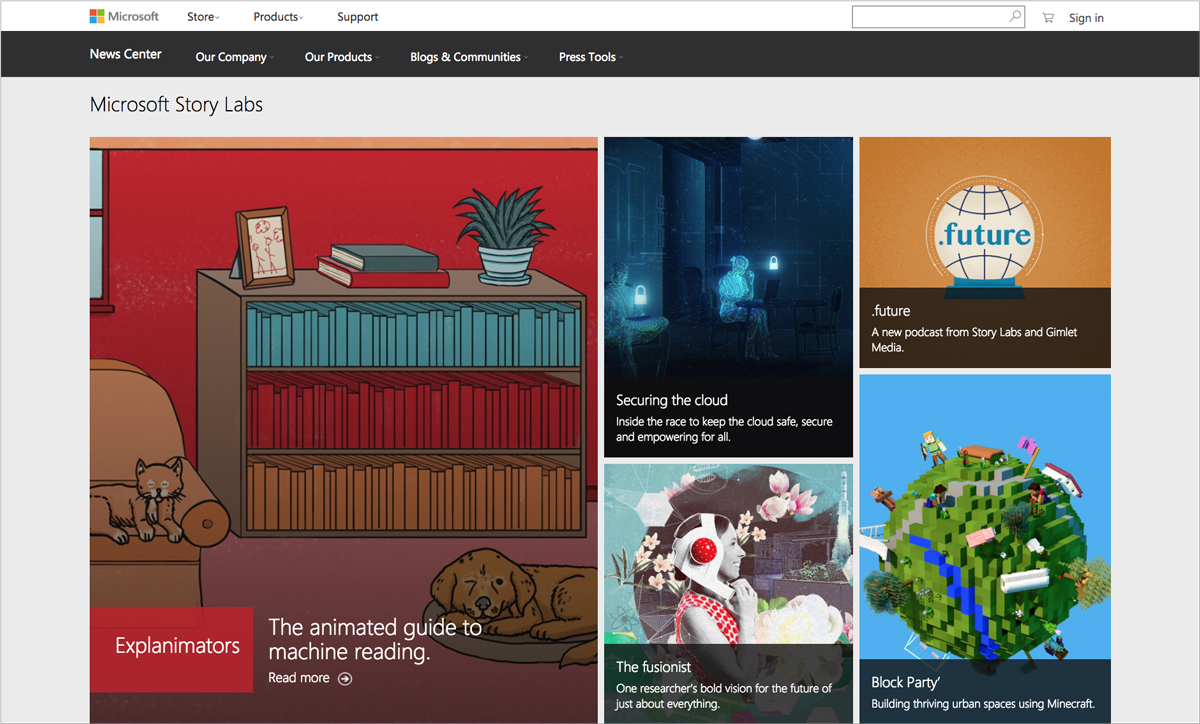It’s a sad thing to admit, but trust is a scarce commodity these days.
Faith in institutions, from government and media to businesses and NGOs, has hit an all-time low across the globe. Meanwhile, only 16% of Americans trust the news that they read on the internet.
In an age when readers question everything, how can you tell your brand’s story in a way that is both credible and entertaining?
As the content manager of a branded blog with more than a million unique visits a year, we get a good amount of feedback from readers on a weekly basis. When we first started it two and a half years ago, most comments were along the lines of, “Hey, I found this really useful.”
This year, we began venturing into the new territory of provocative, long-form content and started to get a lot more comments like this, “Thanks for this interesting piece, but how can you make point ‘so-and-so’ based on just one study?”
This is when I knew it was time to put my journalist cap back on.
From that point on, I didn’t just commit to thoroughly fact-checking all submissions, but also applying other skills I learned as a reporter that have vastly improved my work as a content marketer.
And I’m not the only one. Some of the most successful branded content creators have also drawn from their experience as journalists: Ann Handley began her career as a business journalist before becoming one of the world’s most influential content marketers; Tomas Kellner was a business reporter at Forbes before becoming the managing editor of General Electric’s online publication; Steve Hamm was a senior technology writer at BusinessWeek before joining IBM as a communications strategist; and the list goes on…
What is it exactly that makes journalists especially adept at creating content that resonates with audiences?
Here are nine things I believe give journalists an edge over marketers when it comes to creating compelling and credible content.
1. Journalists Put the Readers’ Needs First
Journalists pride themselves on their independence from political agendas and business interests, allowing them to put the reader’s needs first—at least in theory.
What if your brand could create content focused solely on your audience’s needs?
Microsoft’s Stories site did just that—and they came out winning. Besides earning widespread media attention as one of the best brand storytelling sites, they actually generated sales from interactive longform stories like “88 Acres,” which drew the interest of several real estate and Fortune 500 companies looking for a cost-effective way to turn any building into a “smart” one.

What audience-centered (and potentially profitable) ideas have been stifled within your company by the desire to cater to a specific ROI, above all other things?
2. Journalists Get the Facts Straight
Having worked as both a journalist and branded content creator, I can say that one of the main differences between the two is the level of commitment to getting the facts straight.
For a journalist, there is no detail too small that doesn’t need double (or triple) checking. From name and dates to statistics, calculations and quotes, everything has to be cross-checked with other sources and go through several pairs of eyes before publication.
To see how necessary these same fact-checking processes are in marketing, just take a look at some widely disseminated statistics which turned out to be not true, such as the fact that visuals are processed 60,000 times faster than text or that women control 80% of household spending.

While most branded content teams don’t have the resources to hire fact-checkers and copy editors, writers and editors can still take the time to fact-check all their work using a simple checklist like this one. This can go a long way in preventing marketing’s own epidemic of fake news and protecting your reputation in a field that relies almost completely on a relationship of trust with customers. As the saying goes, “an ounce of prevention is worth a pound of cure.”
3. Journalists Make the Complex Simple
There are few things more off-putting to readers than an article full of complex terms and jargon. Luckily journalists are taught to make things as easy as possible for readers by using simple, straightforward language in place of opaque terms that make concepts inaccessible to the general public. Marketers would reach more people if they did the same.

Take a look at how this interactive story by the University of Minnesota keeps its audience engaged and steers clear of technical terminology, even when dealing with a scientific subject such as the effects of addiction on the brain.
4. Journalists Have a Nose for News
In a world suffering from content overload, the ability to find a news story even in seemingly ordinary events or information is an especially valuable skill for a marketer to have.
Far too many content marketers make the mistake of covering the same topic for the umpteenth time, while a good journalist would strive to find new, unconventional and provocative angles, even in “unsexy” industries such as finance or insurance.

An alarm system is usually not something that gets your pulse racing, but take a look at how this well-executed story by Nest grabs your attention in an instant and keeps it until the very end through a combination of media formats, including video, audio and interactive graphics.
5. Journalists Know How to Tell Stories
One of the marks of a good journalist is the ability to inform, inspire and entertain—all at the same time. The most effective way to do this is through storytelling based on facts.
Whether it’s through a human-interest story, a nuanced profile feature or a stunning multi-page photo reportage, journalists know how to capture their readers’ attention right from the outset.

Take, for example, this long-form piece for MEL, a digital magazine for men started by the Dollar Shave Club in 2015, now staffed with dozens of journalists and writers. Written in first person, it narrates the experience of buying a gun from the perspective of a person who would never own one otherwise.
6. Journalists Get the Story First-Hand
Instead of citing quotes and statistics gleaned from other sites and press releases, journalists practice (at least in theory) what is known as good, old-fashioned “shoe-leather” reporting. They go to the scene of the story; they interview those involved; they cross-check claims with other experts; in other words, they get the story straight from the horse’s mouth, not secondary sources.

Look at how this investigative online story sponsored by Amazon was put together using in-person interviews, original documents and other traditional reporting techniques used to cover murder investigations.
While marketers won’t need to become investigative journalists any time soon, learning a few reporting techniques may help to quell the spread of inaccurate claims, which is especially necessary in this age of fake news.
7. Journalists Strive to Be Objective
While some believe objective journalism is a myth (as humans can never be truly objective), the act of striving for impartiality is a fundamental part of the journalistic ethos.
Reporters may come with all kinds of subjective points of view, but the methods they use to report are in themselves objective. For example, journalists are taught to cover all sides of an issue equally and avoid adjectives, adverbs and any other words that may indicate even a hint of bias.
By the very nature of their work, marketers can never be impartial—and we shouldn’t expect them to be—but they can at least strive for greater transparency and authenticity in the way they cover company news, which may serve to build greater trust in the brand in the long run.
For example, in 2006, Robert Scoble, one of Microsoft’s well-known corporate bloggers, openly criticized the company for blocking the site of a Chinese blogger at the request of the Chinese government. Instead of censoring Scoble, the company accepted the criticism, which in the end was a PR win for Microsoft.
8. Journalists Use a Variety of Formats to Tell a Story
After The New York Times’ hugely successful “Snow Fall” piece was published in 2012, media companies everywhere followed in its footsteps by releasing their own interactive longform narratives.
Pretty soon The Guardian, The Washington Post, National Geographic, among many others, started to emulate this unique storytelling format, which seamlessly combines a variety of media (video, audio, images, interactive graphics) into one engaging piece.

The most innovative brands are also following suit with their own immersive interactive stories, such as this audio interactive piece sponsored by the car company SEAT. Take a look at how infinitely more engaging this is than a text-only article would be on the subject of innovation.
9. Journalists Are Always on the Lookout for New Trends
Finally, successful journalists always have an ear to the ground, ready to cover the latest trend, fad or juicy bit of information.
While this doesn’t mean marketers should become embroiled in industry gossip, many could benefit from closer monitoring of trends and active social listening to find out not only what customers are saying about their brand, but also what other topics of discussion are on their minds.
You never know, keeping a finger on your audience’s pulse may allow you to address a widespread concern or provide some much needed insight with a well-timed post or tweet.
Which of these journalistic practices has worked well for your brand? Anything we missed? Let us know in the comments section below.
